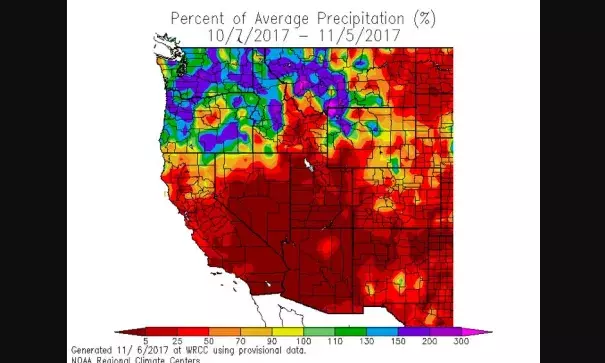Occasional NorCal rain, but dry autumn continues across Southern California

October was an exceptionally hot month in Southern California, with numerous high temperature records falling across a broad region. Many SoCal sites set new records for their hottest temperatures for so late in the calendar year–well into the triple digits in most places, even near the coast. Most of Northern California was still quite warm, though less anomalously so. Temperatures have finally cooled in recent days back toward seasonably cool levels.
Meanwhile, the rainy season has thus far gotten off to a pretty slow start across most of the state. While most of NorCal has now seen wetting rainfall (and, in some spots, “fire season-ending” accumulations), the southern part of the state has thus far been quite dry so far this autumn. Dry autumns are not necessarily that unusual in Southern California–and, as I’ve previously discussed, do not necessarily foretell a dry winter to come.
...
Blocking ridge in Gulf of Alaska: Snow in Seattle, but sunny in SoCal
A very strong blocking ridge of high pressure has developed over the northern Gulf of Alaska in recent days, leading to a high-amplitude flow pattern over the North Pacific and inducing all kinds of unusual weather to the east. Southern California recent dryness is partially attributable to the atmospheric wave pattern induced by this “boulder in the stream” to our northwest, though weaker subtropical ridging had been the bigger player during much of October. High pressure in this region also tends to result in cold air outbreaks over the western Canadian interior, as cold Arctic air spills southward (and even southwestward) on the east side of the ridge. This strong ridge is no exception: over the weekend, a fairly remarkably early season Arctic outbreak brought rare early November snowfall to sea level in Vancouver and Seattle. Seattle usually only sees snow once or twice a year (and some years, none at all!), making this light dusting one of the earliest on record.
This unusual cold over the Pacific Northwest, though, is more than counterbalanced by extremely warm temperature anomalies over the Arctic Ocean just north of Alaska resulting from this ridge. Amazingly, sea ice has yet to form in the Chukchi and Bering Sea (and, remarkably, mostly ice-free seas are still visible in the live webcam view from Utqia?vik (Barrow)). There have been a spate of recent winters exhibiting similar high-latitude blocking patterns, with a resulting “warm Arctic” and “cold continent” pattern developing during successive weeks. There is quite a bit of ongoing research exploring these events and their potential connection to sea ice loss (along with weather extreme-related impacts further to the south).


